By Willem Oosthoek
The above title quote is how a Maserati-loving bottling magnate always ended his correspondence.* The bottling magnate was J. Frank Harrison Jr., whose father was a nephew of John T. Lupton, one of the Coca-Cola pioneers.
In 1889 Lupton paid $1 per gallon in perpetuity for the syrup that enabled him to bottle the beverage, which up till then had been solely available as a 5 cent fountain drink at the soda counters in drug stores. Based in Chattanooga, Tennessee, the Harrison family bought the bottling franchise in Greensboro, North Carolina in 1902, covering the Piedmont region. It was called the Chattanooga Glass company and the Cola beverage was originally delivered by a slogan-decorated horse drawn carriage. A fleet of trucks joined the glass company over time.
J. Frank Harrison Jr. was born in Chattanooga in 1929. After a stint in the U.S. Marines he joined the family firm, but cars soon dominated his world. A neighbor across the street owned an MG TD and Frank was smitten. He bought a modified Jaguar XK 120, white with red interior, and this was soon followed by a tubular framed, Devin bodied, flathead Ford powered special that he used in a few local hillclimbs.
In March, 1957 Frank attended the Sebring 12 hour event, won by Juan Manuel Fangio and Jean Behra in a works Maserati 450S. In August at Virginia International Raceway in Danville, he witnessed another Maserati overall victory. This time it was Carroll Shelby beating the Cunningham D-Types in John Edgar’s 450S. The young industrialist decided he had to have a V8-engined 450S himself and ordered one via Carroll Shelby Sport Car Inc. (CSSCI), a Maserati dealership in Dallas, Texas, founded by Dick Hall and Shelby, who guided Dick’s younger brother Jim in his early racing efforts.
The 450S Harrison ordered became chassis 4510, the last of the ten Tipo 54s (their official factory name) built in Modena. Finished on January 2, 1958, the red car was delivered in Chattanooga by March. Its invoice added up to $16,500, which included $320 for four extra Borrani wire wheels. To top it off, Harrison bought an enclosed transporter like John Edgar used. It featured a seating area on the roof for extra comfort and track visibility. Two full time mechanics, Albert Kemp and Bill Warren, would take care of his new toy. At only 29, Frank now had the fastest sports-racer in the world, a 400 BHP, 1735 lb. brute, good for 185 mph. But who was going to race it?
Since the new owner had little road racing experience, let alone in such a powerful car, he invited his friends to give it a try. The first one was Dan Clippinger, a Chattanooga VW dealer, who had raced production MGAs in SCCA events. Entered in the May SCCA regional at Chester Airport in South Carolina, under Frank’s favorite race number, 26, Clippinger faced opposition from Ed Rahal and C.K. Thompson, both in D-Types, and E.D. Martin in a 3.5 liter Ferrari Monza. In spite of two spin outs, Clippinger gave chassis 4510 its first victory. Relieved to have brought the car home in one piece, he declined to race it any further.

A happy Dan Clippinger after taking the Harrison 450S to its first victory, at Chester in May 1958. Photo by Nedra Ware
Another one of Harrison’s friends had more experience with powerful cars. Walt Cline, the owner of W.M. Cline Company, a photo developing business with 34 camera shops around the Southeast, had raced Corvettes before. He was willing to take Clippinger’s place at Courtland, Alabama, in August. Victorious in the preliminary, the 450S was withdrawn from the feature with low oil pressure.
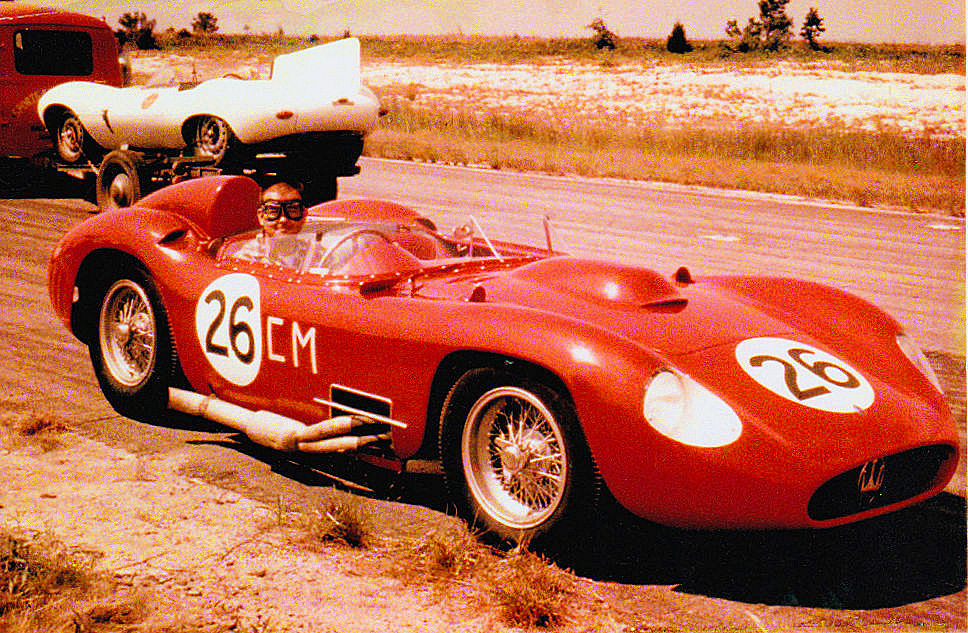
Chief Steward and good Harrison friend Prentice Knapp tries out the 450S for size. Ed Rahal’s D-type passes in the background and note the blooming cotton fields. Walt Cline ran the car on race day. Photo by Bob Bellows
In October at Dothan, Alabama, Cline finished second behind E.D. Martin’s Testa Rossa, only to retire with a broken oil line in the feature. Since Cline’s wife was strongly against his racing, he had to do so in secret. One day she visited the Harrison garage where chassis 4510 was being prepared for its next outing. In a fit of fury Mrs. Cline attacked the car with a lead hammer, damaging its Weber carburetors. Cline, who valued domestic peace more than competition, quit racing on the spot. So Harrison was without a driver once again and 4510 saw no action for the rest of 1958.

Coffeyville, Kansas, May 1959. Jim Hall and Harrison mechanics Bert Kemp and Bill Warren next to Frank’s 450S, which Hall would drive in the feature. On the right is Jim’s regular car, his Lister/Chevy. Photo by Bob Jackson
The 450S was sent off to CSSCI in Dallas for repairs and now Jim Hall became involved. With Harrison’s permission, he entered the Maserati, as well as his own supercharged Lister/Chevy, at Coffeyville, Kansas, in May of 1959. He had never raced a 450S before, but after winning the prelim with his Lister/Chev, decided to give the Harrison car a try for the feature. After claiming the car’s second feature victory in its brief history, Hall mentioned he preferred racing the Maserati over his own Lister.
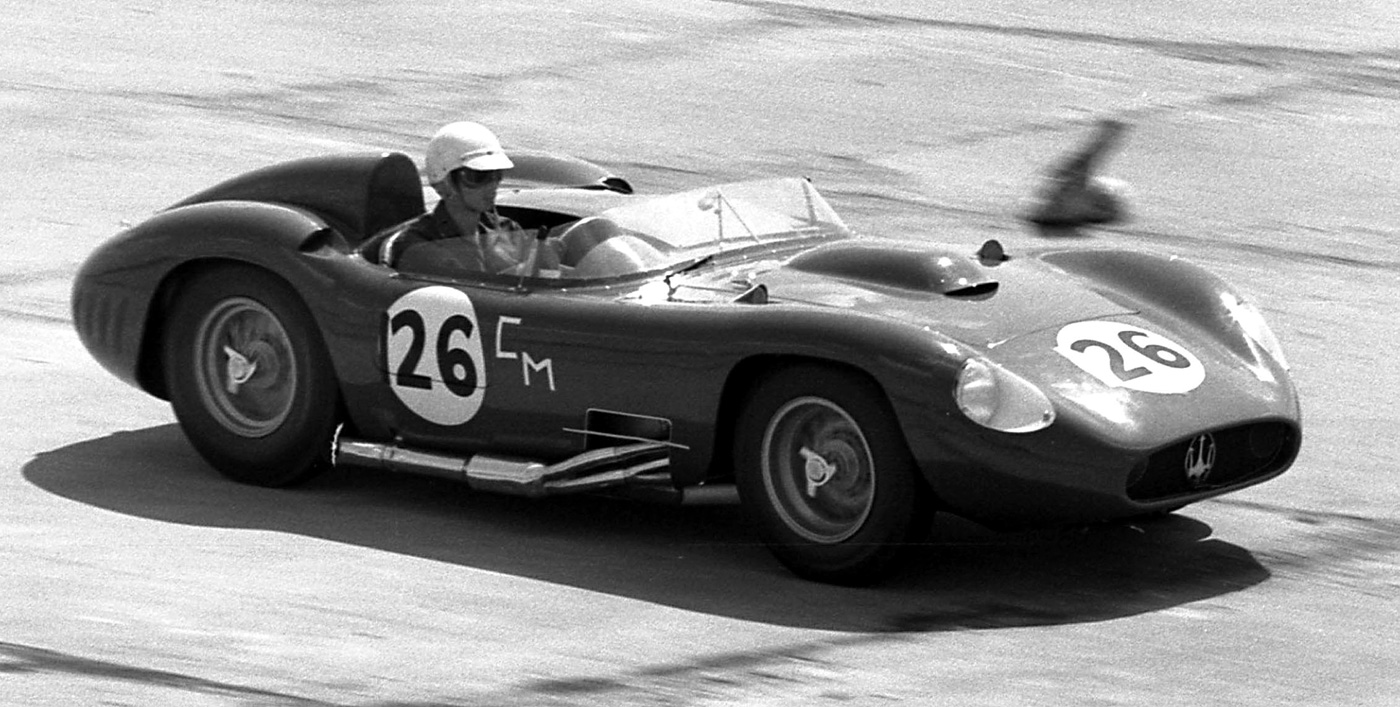
Coffeyville, Kansas in May 1959. Jim Hall about to score an overall win with 4510. Photo by Bob Jackson
The timing was right for Jim Hall. During Hall’s vacation in Europe, Jim Rathmann raced the Lister/Chevy with Jim’s permission, at Meadowdale in September 1959. After its brakes failed, Rathman rolled the car and after the wreck arrived in Dallas, Hall sold it. Now Hall was without a car and Harrison’s invitation to race the 450S in the Southeast was most welcome.
Without a nearby racetrack, Chattanooga may have been a backwater when it came to sports car competition, but Frank was well-connected. He developed a close relationship with David Brown and Reg Parnell of the Aston Martin team, offering to pick up their DBR1/300 in New York with his transporter for the long trip to Sebring in 1959.
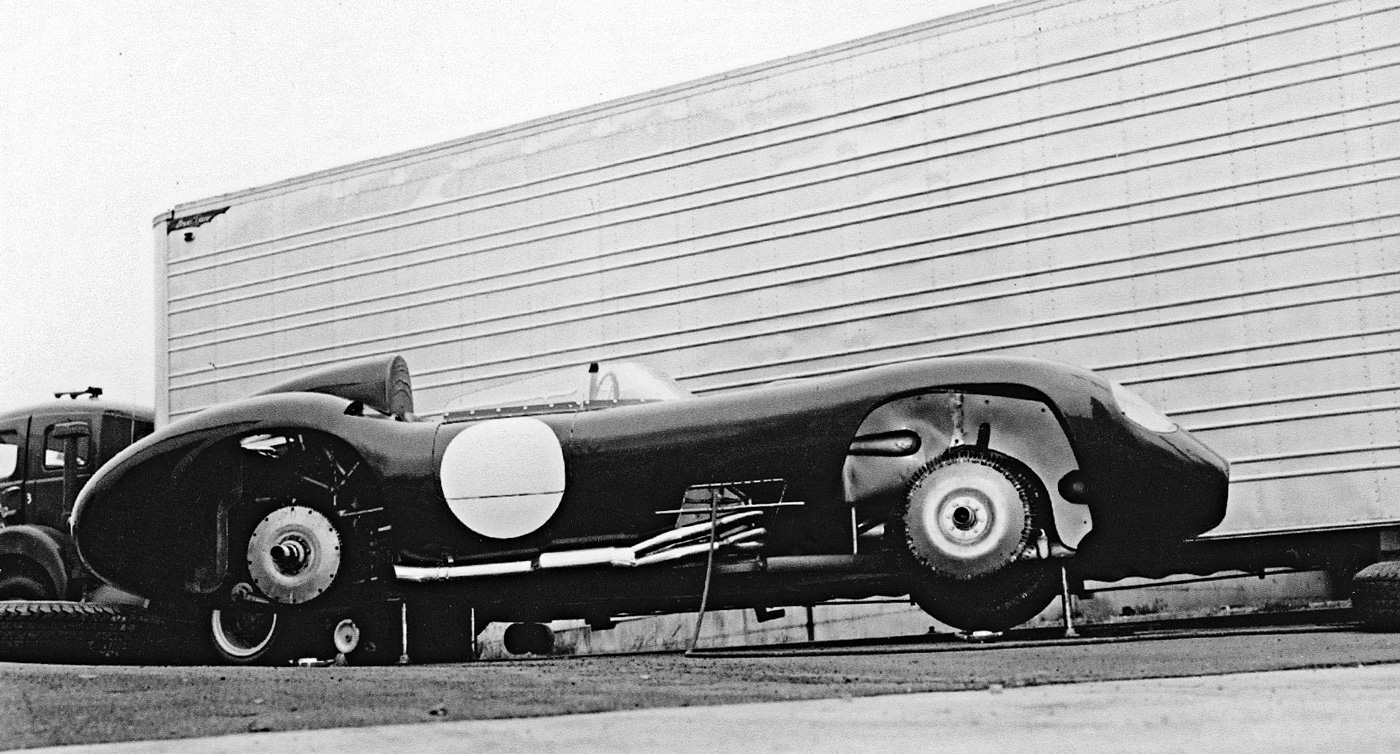
In front of the Harrison transporter, chassis 4510 after the Chapman Root air jack design was installed for faster pit stops. According to the owner: “Just stick a hose in it and the car would pop up.”
As a result, the Aston Martin team invited him as an honorary guest at Sebring and Le Mans. Harrison also provided Parnell with the design of an air jack used on the Indianapolis Sumar Specials of his friend Chapman Root. A fellow Coca-Cola bottler from Terre Haute, Indiana, Root’s family had won the classic Coke-bottle design contest in 1915. Frank installed the air jack design on his own 450S and Aston Martin used it in the season-ending Tourist Trophy, helping them to secure the 1959 Word Championship for sports cars.

Courtland, Alabama in October 1959. Bill Warren working on Frank’s 450S V8 engine. Photo by Bob Bellows
Two Alabama events followed for Jim Hall and chassis 4510. At Courtland in October, Hall won the preliminary, but had to pit for new rubber in the feature, which dropped him to third at the finish. At Dothan two weeks later, Harrison installed harder Dunlop tires, obtained via Reg Parnell in England. Unfortunately, the team faced E.D. Martin in the first Birdcage Maserati Tipo 61 to appear in the U.S.

Jim Hall ran chassis 4510 at Courtland in 1959, but in this photo the driver is too short to be Jim. One of Frank Harrison buddies, Chief Starter Jesse Coleman is at the wheel warming up the car. Photo by Bob Bellows
Harrison tried to lure Martin into thinking the 450S would make a tire change, although the Dunlops would not need changing. In the end, Martin discovered the ruse and sped up, beating Hall and 450S by a car length.
Dothan proved that the 450S was faster on the straights, but that the Birdcage out-handled it in the turns. Both Harrison and Hall decided they wanted a new Birdcage as well and placed their orders. However, the Tipo 61 waiting list was so long that they did not receive their cars until well into 1960.

Nassau, December 1959. Jim Hall [Harrison 450S] chasing down the Ferraris of Alan Connell [335 S] and Pedro Rodriguez [250TR]. Photo by Alice Bixler
Only Nassau remained on the 1959 calendar. Jim ran the Harrison 450S against strong competition, finishing fifth in the Governor’s Trophy and ninth in the Nassau feature race. This was the end of the competition life for chassis 4510, although Jim Jeffords and Jim Hall practiced in it for the 1960 Road America 500. They found it too heavy and tiring for a 500-mile race and opted for Harrison’s new Birdcage. In May 1961, Fred Gamble blew it engine during a private practice session at VIR, Danville. Although a new engine was installed, the 450S never saw competition again.
But Frank Harrison still had that burning desire for the Maserati Tipo 54, even if uncompetitive by now. In September, 1960 he bought the Ebb Rose 450S that Rose and Lloyd Ruby had raced as Micro Lube Specials. It was chassis 4509, and Frank planned to enter it in the 1961 SCCA circuit, just for fun. He recalled, “The Rose car was too good a deal not to take advantage of. It was in good shape and could still run the SCCA races.” Nothing came of these intentions, though.

Nassau, December 1959. Before Lloyd Ruby became Frank Harrison’s regular driver, he raced Jim Hall’s chassis 4508 with 5.7-liter engine in the Nassau Trophy, after Carroll Shelby refused it. Harrison bought the car in 1961 and Ruby and the car were re-united at Indianapolis Raceway Park . Photo by Bob Bellows
A much more competitive Tipo 54 came Frank’s way in April of 1961. This was chassis 4508, originally owned by Temple Buell, with a 4.7 liter V8. Drivers such as Masten Gregory, Carroll Shelby, Juan Fangio, and Maurice Trintignant had occupied its seat. In 1959, Jim Hall bought the car from Buell and had it completely rebuilt in Dallas. Based on the 5.7 liter Maserati marine engine, Hall call it the 5.7, but in factory terminology it would have been a 570S. After some initial disappointments in 1960, Hall took it to wins at San Marcos and Galveston, Texas. After a final victory at Mansfield, Louisiana in March, 1961, he found an eager buyer in Frank Harrison, just a few weeks later.
Frank loved his third Tipo 54. “The car was a real collector’s item. It had a 5.7 liter engine with the gas pedal between the brake and clutch for heel and toeing. Hall made me a good deal.” Entered with Lloyd Ruby as driver at the Indianapolis Raceway Park for the two-heat USAC Sports Car Championship Hoosier Grand Prix in June 1961, the car won the first heat. In heat 2, Augie Pabst’s Scarab led over Ruby, but since Pabst only finished third in the first heat, the Harrison crew signaled Ruby to take it easy. A second-place finish in heat 2 would give him first overall, or so they thought. Unfortunately, the rule book said the overall win was to be based on aggregate times, not finishing positions. The unchallenged Pabst made up the 47.2 second heat deficit to win by seven seconds over the Harrison car.
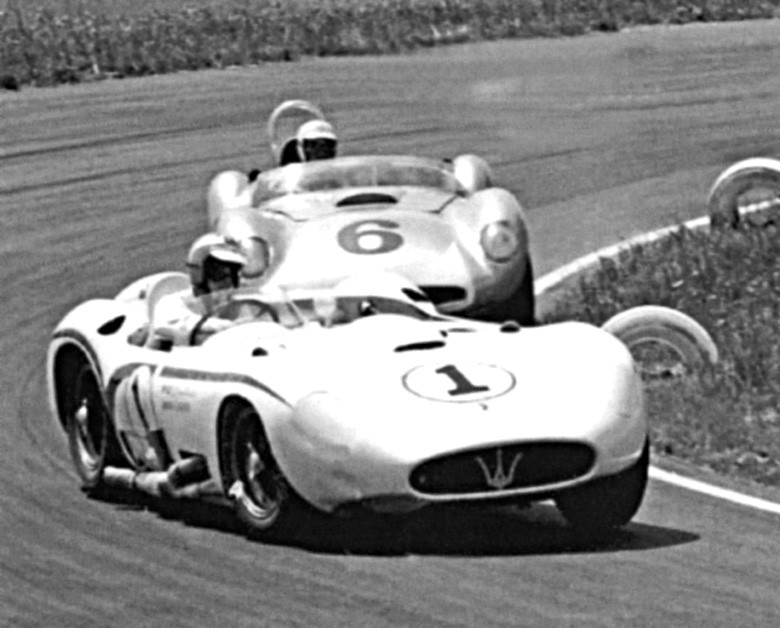
Lloyd Ruby in the Harrison 570S leads Augie Pabst’s Scarab Mk 2 during the June 1961 Hoosier Grand Prix at IRP. A misinterpretation of the rule book cost Lloyd, and Frank, the victory. Photo by Ron Nelson
The final appearance of the 4508 chassis came at Courtland, in July 1961, where Bill Kimberly was invited to drive it. Kimberly recalled, “The 5.7 was wide and huge, so powerful with tremendous torque. I qualified on the front row, but when they dropped the flag, and I stepped on it, I only went about 20 yards. The differential broke.”
By now Harrison was heavily involved as a race driver himself, mostly in Formula Juniors, He also fielded his newer Birdcage Maseratis and became involved in Formula One and USAC racing with Ruby. The three older Maseratis were of little use anymore. After an unsuccessful attempt to turn chassis 4510 into a ‘street machine’ by installing Corvette disc brakes and a four speed gearbox, it was sold in 1968 to Steve Hammatt in Washington State for $2,500. The deal included the original transmission and finned aluminum drum brakes.

Chassis 4510 seen from the top of the pits in Coffeyville in 1959. It is no surprise that Frank Harrison fell in love with this car. Photo by Bob Jackson
The other two went earlier. An article in the Chattanooga paper mentioned how Wick Williams, a young student in Chattanooga and scion of the Sherwin-Williams paint empire, recorded some fast laps at Courtland in the Harrison 570S. However, in the end, (based on period photos) Williams settled for the old Ebb Rose Micro Lube chassis 4509. Williams ran it with a sinister mat black paint job at Courtland and Daytona in 1963, before moving on to a Lotus 23.
As for the white 570S, a racing fan found the car in the mid-sixties under a tarp outside of Graham Shaw’s shop near Columbia, South Carolina. Chassis 4508 was inoperable and in a sorry state. Apparently, there was a dispute about the condition in which it had been delivered to Shaw. A sad condition indeed for what Frank had called a collector’s item.
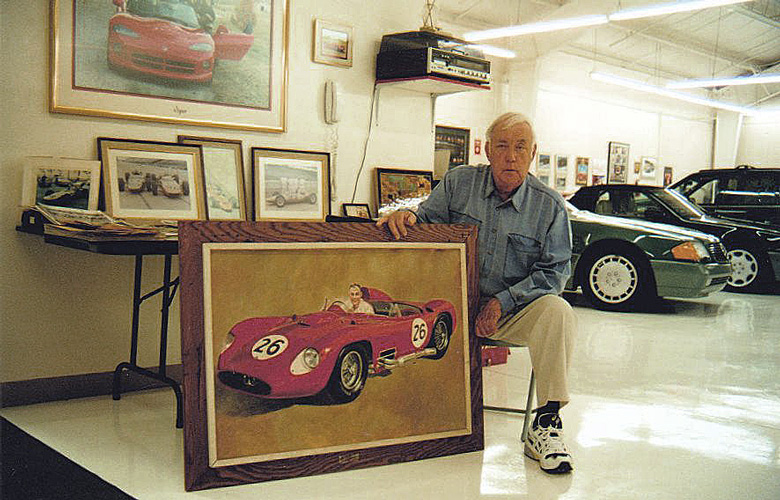
Chattanooga, 1997. Industrialist J. Frank Harrison showing a painting of himself in his favorite 450S, chassis 4510.
Frank Harrison never used his racing activities to promote Coca-Cola. He was a true enthusiast in the mold of Lindsey Hopkins, John Edgar, Joe Lubin, Tony Parravano and Frank Arciero. They all spent large amounts of money for the love of the sport, an eclectic group of personalities covered by the mid-fifties term “sportsmen.” It was Maserati that started Frank’s passion and in a 1997 interview, he confessed he regretted selling his original chassis 4510, as well as the Buell 4508. Of his first purchase, he said, “She was just brute strength. She was a big hunk of iron, but she had beautiful lines. The brakes were horrible – they tended to fade. You’d bed them in, you’d go out and stand on them, they’d lock up and you’d spin! But it was a great car and the engine was beautiful.”
After his big Maseratis became less competitive, Harrison continued with two Birdcage Maseratis.
But that is a story for next time.
*The title is the Coca-Cola slogan for the year 1979, but also Frank Harrison’s sign off on letters he wrote to the author, an example below. The article that Frank referred to was Willem’s 1997 interview with him, published in Maserati club magazine Il Tridente.
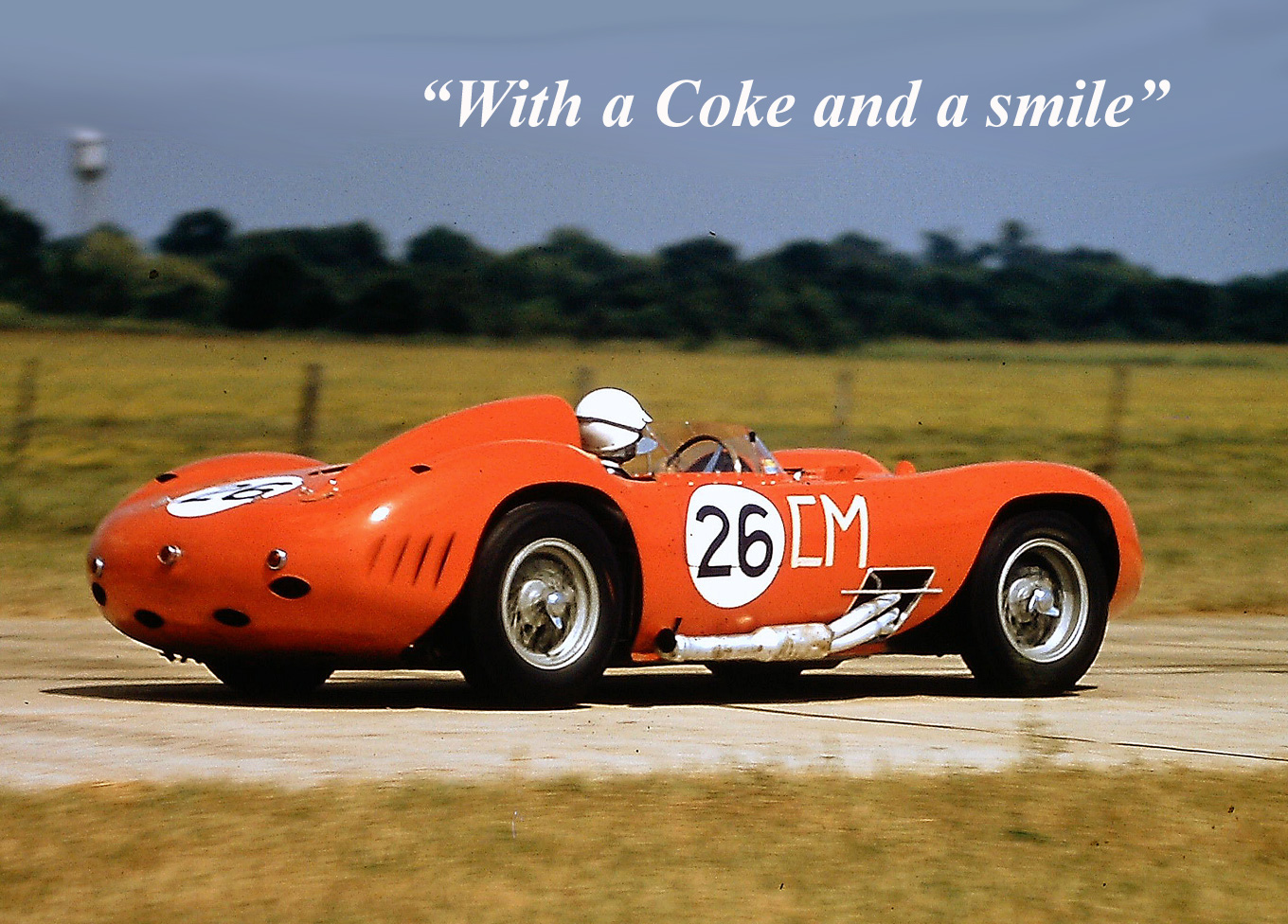

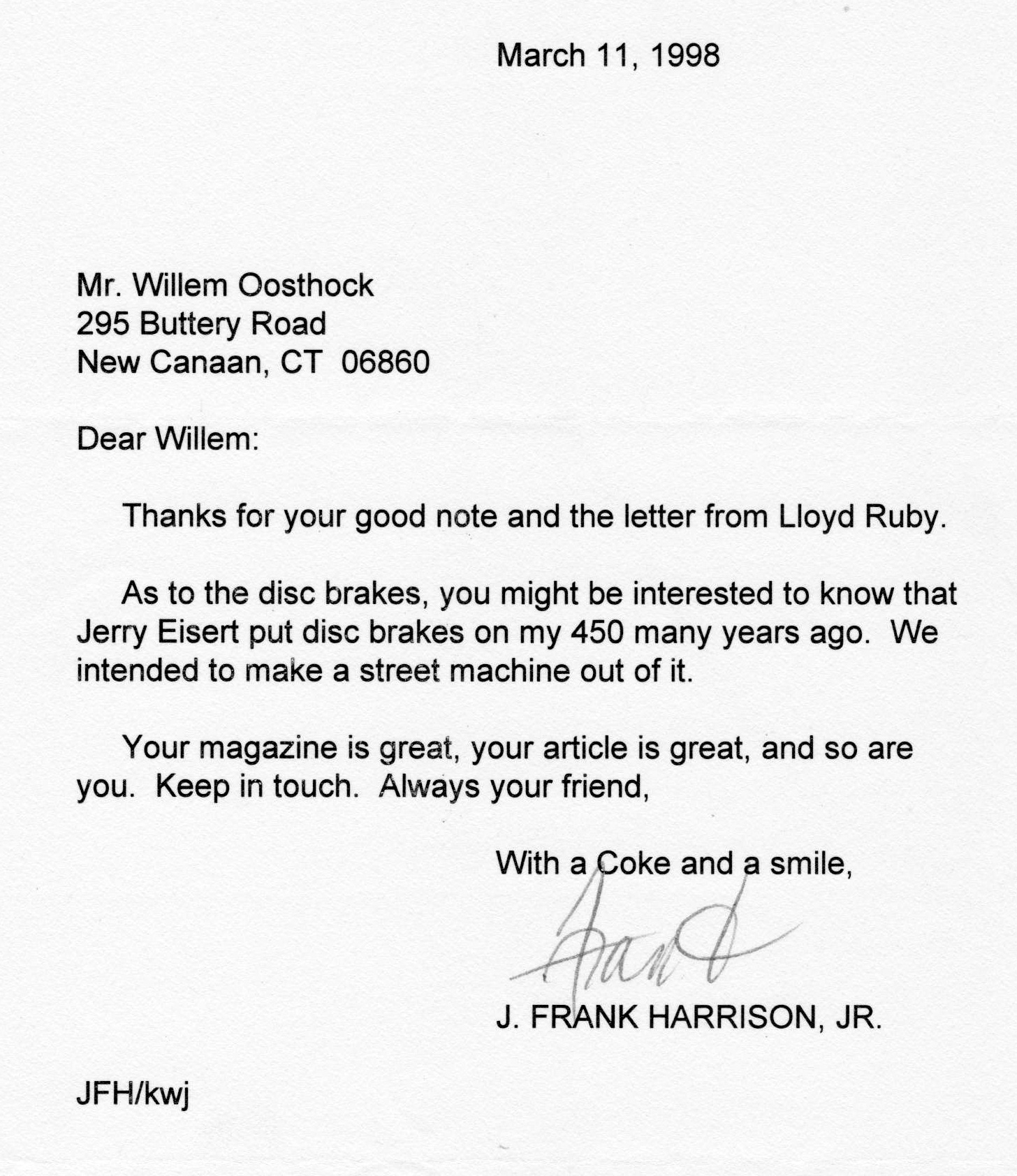
Excellent article that had me hanging at every word until the last. Made my week! I love Maseratis and always heard the monstruous 450s.
What a great article about a amazing time in motor sports history ! So much detail and the photos are spectacular. Hard to imagine going into battle with those heavy monsters with marginal brakes ? How did Behra and Fangio make them last for 22 hrs ?
I saw the title and thought it was about Stirling Moss and the coke bottle at Sebring. Was he driving a 450s or a Birdcage? Memory fails…
charley
I attended the race on Galveston Island and watched my hero Jim Hall win with that 450. What was even more fun was watching Hap Sharp running a 2 litre Birdcage that he literally threw around the corners. What a wonderful era. My father and I went into the pits after the races and had a chance to talk with the drivers and mechanics. I had just recently acquired my drivers license and wanted my father to buy one of those cars for me. There were two Houston Oil men who had matching 300s racers during that period and they put on some fine shows at the old Galveston course.
This is a beautifully written article, and of course we would expect nothing less from Willem, who must be the pre-eminent Maserati historian.
Says Oosthoek: As for Charley’s comment, that famous Bernard Cahier photo of Stirling Moss receiving and drinking a bottle of Coke in a slow corner was at Sebring in 1957, where he raced a works 300S Maserati to second place.
Living in the LA area in 1962/63, I had the opportunity to buy a 450S from Pacific Auto Rental for $4,500. PAR was a company that catered to the local movie industry. Don’t know the serial number. Saving money for going back to school, meant no 450S was to be in my future. Another missed opportunity. Thanks for a little bit of insight on what it was like to race some of these beasts. Having seen the front wheel/king pin offset on one of these at a Gooding auction a few years ago, I can see why Jeffords and Hall demurred at using 4510 in a 500 mile race when a Birdcage was available.
Randy Reed
Willem will be a great addition to your writing staff. Veloce Today readers will enjoy his articles capturing the true enthusiasts who were so instrumental in making racing so interesting and enjoyable.
Thank you Willem and Veloce Today for an informative and interesting article documenting not only Maserati history but sport car racing history as well.
didn’t hall run Harrison’s Maserati at the first stuttgart, ark., races in ’59? and I kinda remember a Maserati there in primer or painted a dark color, with a cartoon of Charlie Brown on a rear corner, asking ‘what’s the name of this game?’ j frank offered me the long-windshield 5.7 for my lotus 7a and $6k. he said I was the only person he knew who might not kill himself in it; I’ve always wondered if that was a compliment or not.
Oosthoek writes:
Toly,
Your memory is excellent! At Stuttgart, Arkansas in April 1959, Jim Hall decided to try out the Buell-owned 570S, still painted dark blue. After Carroll Shelby raced it last at Pomona in March, the car had been dropped off at CSSCI in Dallas.
Interested in buying chassis 4508, Hall wanted to try out its capabilities first. But when the car was eased off the trailer, its rear end blew and Hall was forced to race his Chevy-engined Ferrari Monza instead.
Hall bought the 570S anyway, rebuilt it from the ground up and had it painted white.
This is a good story about a really nice guy and about my all time favorite race car,4508, and I worked on a lot of different race cars.
To Cortes Pauls, that Galveston race was fun. We knew there was no competition for Jim and 4508 so before the race Bob Stonedale, asked Jim to make it look like a real race so with 2 laps to go I gave Jim the signal and he stood on it and pulled about 20 car lengths on Mason O Kieff down the back straight. Poor Mason!
Toly is right about Stuttgart, but it was the clutch that broke, not the rear end, as I tried to back it off the trailer.